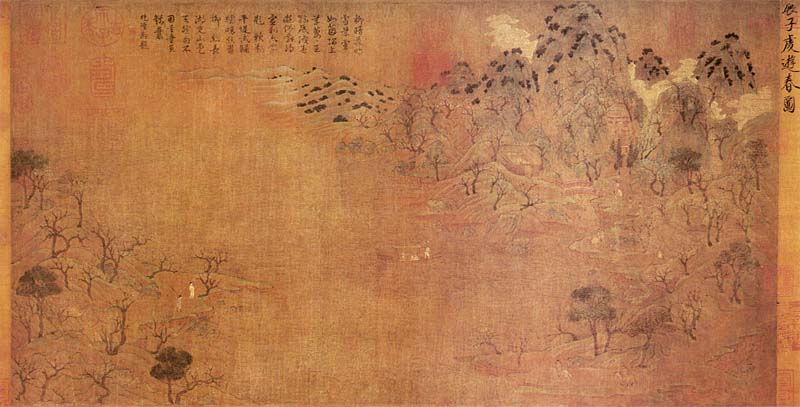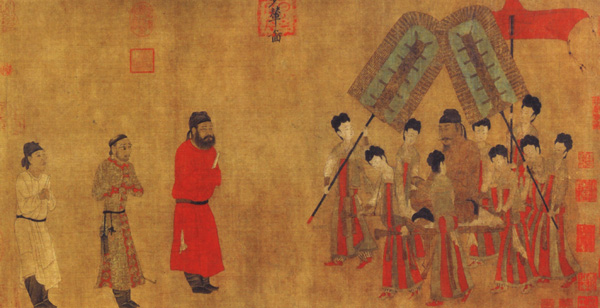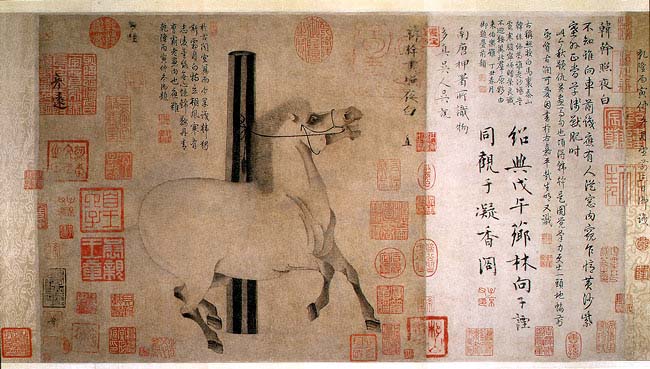|
| |

|

III.
Paintings of the Sui and Tang Dynasties
|
|
The Sui unified China and terminated the division between north and south which had lasted for more than 300 years. The cessation of war and the stability of society ensured the development of art. When the royal family constructed large-scare palaces, revived Buddhism, built temples and Buddhist caves, magnificent murals were flourished at the same time; the more than 70 caves of Sui Dynasty at Mogao Grottoes can be taken as a proof of how popular the Buddhist murals were. The unification of the country attracted famous painters such as Zhan Ziqian, Yang Zihua, Dong Boren to the Sui's capital Luoyang, among whom Zhan Ziqian was the most outstanding one. Zhan was good at Taoist and Buddhist painting, figure painting, landscape painting, and so on. His "Spring Excursion" (collected in the Palace Museum in Beijing) is the earliest existing scroll painting, from which we can learn how the independent landscape painting was like in its early stage.
|
 |
|
Tang Dynasty is regarded as a high point in Chinese feudal society, a period of prosperity and progress, and a golden age welcoming various innovations. Chang'an and Luoyang became two very cosmopolitan cities which witnessed the collision and communication between diverse cultures; nobles and scholars had adequate nutrition to research all types of knowledge, and engage themselves in all kinds of arts. The Tang Dynasty painting, based on inheriting the excellent tradition of the Six Dynasties since Han and Wei, had presented an unprecedented new look in terms of absorbing foreign artistic nourishment, subject, style, and technique. Figure painting was still the mainstream in Tang Dynasty, whose subjects include political events, nobles and court ladies, saddle-and-horse, and pastoral scenery; the figure painting turned away from previous stylized look and conceptual mode by emphasizing on the depiction of characteristics; the ingenious elaborate brushstrokes as well as the magnificent powerful style both breathed the spirit of the Tang Dynasty. Landscape painting, as an independent art genre and occupying a more important position in Chinese painting history, had developed into two systems, the blue and green landscape painting (a decoratively colored landscape style) and the ink landscape. Flower-and-bird painting had become an independent painting genre as well; modes of expression like meticulous coloring, inking with light colors, and boneless skill appeared. Buddhist painting that arose in the six dynasties reached its peak in Tang Dynasty. In general, the Tang Dynasty painting achieved more than the previous dynasties and, with its almost matured painting genres and its influence spread over the oriental countries, reached a peak in the history of Chinese painting. |
 |
Li Shimin, the Emperor Taizong of Tang, who learned lessons well from the successes and failures of the past dynasties, put emphasis on cultural policies. He required painters to fully support the needs of political reign, for example, to paint the country's major political events or the life of nobles. Thus, almost all of the famous existing Tang Dynasty paintings are related to the royal and nobilities. Yan Liben and his father Yan Pi, his brother Yan Lide were all outstanding painters at that time. Yan Liben's "Emperor Taizong Receiving the Tibetan Envoy" depicts a political event happened in the fifteenth year of the Tang Dynasty Zhenguan Period (641 AD) when the Emperor Taizong of Tang met Gar Tongtsen Yülsung, the envoy of Tubo (present-day Tibet), who came to Chang'an to accompany the princess Wencheng back to Tibet. In this painting the Emperor Taizong of Tang looks elegant and poised, while the envoy of Tubo stands aside and holds the emperor in awe, which mirrors the relationship between China and the northern nations at that time as well. |
|
Another example is the imitated copy of Yan Liben's "Portraits of the Emperors", in these paintings subtly defined characters has been imbued in each emperor and made them look different. What is worth mentioning is that the size of the figures does not accord to the actual people's size, but to their rank and social position. This tradition of figure painting has been followed by Chinese painters generation after generation until the end of the feudal era. Yan Liben became acting You Xiang -- the head of the examination bureau of government and a post considered one for a chancellor, and was well-known as "the famous You Xiang painter".
During the Kaiyuan years Wu Daozi was summoned by the Emperor Xuanzong of Tang and appointed as a deputy fifth-rank official at court for his painting skills. He was a all-rounder in painting whose talent was shown in a wide range of subjects including figure, bird-and-beast, plants, ghosts and gods, landscapes, buildings and palaces, thus he was called "Hua Sheng" (the painting sage). When painting figures, Wu used dry ink to outline the figure first, and then put only thin wash of color on subject's clothes, to achieve a delicate and graceful effect, which was called the "Wu's wear"; the wrinkle he painted was so smooth with the shape of orchid leaf or water shield, as if it was blowing in the wind, so-called "Wu's belt floating in wind"; the style and format he created in Buddhist and Taoist painting was so popular that people named the style "the Wu School". The "Chaoyuan Celestial Cane" (collected by a private collector in USA) was thought to be an imitated copy of Wu Daozi's "Five Saints of Chaoyuan", from which we can capture Wu's feature. Literati Su Shi appraise Wu highly, "Wu Daozi exhausted all the possibilities of painting in the history".
The court lady painting genre boomed during the Tang Dynasty, and Zhang Xuan and Zhou Fang were the masters of it. Zhang Xuan was an expert in painting court lady, saddle-and-horse, screen and curtain, palace and garden. When he painted court ladies, he liked to dye the basal part of his subject's ears with vermilion color; the women he painted were rounded and splendid; his strokes was delicate and his colors was balanced; he's the forerunner of Zhou Fang's painting of court ladies, and influenced the painting style of the Late Tang and Five Dynasties; he was famous for integrating lifelikeness and rich in cadence when painting life scenes of noble family. |
| Such style can be found in the existing imitated copy of Zhang Xuan's "Lady of Guo on A Spring Tour" and "Court Ladies Preparing Newly-Woven Silk". Zhou Fang came from a noble background and was the next painter who's famous for his court lady painting after Zhang Xuan. He vividly presented the disengaged manner of court ladies, such as his representative works "Court Ladies Adorning Their Hair with Flowers" and "Court Ladies Swinging Fans". The format Zhou Fang created, known as "Zhou School", had influenced the later painters. |

|
The blue and green landscape painting was the mainstream of landscape painting in Tang Dynasty. As a representative painter of this genre, Li Sixun painted in a highly decorative, colorful, meticulous and neat fashion, employing the precise line technique derived from earlier artists Zhan Ziqian (Sui Dynasty). He liked to draw immortals from fairy tales on the mountains to make the landscape more dramatic, and his style was followed by his later peers in a long time. The "Sail, River and Pavilion" collected by Taipei Palace Museum is one of the masterpieces of early landscape painting. His son, Li Zhaodao, was also a famous painter. The "Emperor Ming-huang of Tang Traveling to Sichuan" is regarded as Li Sixun's work, but some scholars believe this is a faithful copy of an original by a Song Dynasty artist. The painting depicts the story when Emperor Ming-huang of Tang fled the capital and sought refuge in Sichuan during the An Lushan Rebellion. In this painting the mountain and forest have a quirky looking, while people and horses are very small and seem bogged down in the nature, seemingly implying a disordered world that the travelers were in. Both Li Sixun and Li Zhaodao were given a rank of general in court, and thus the father is sometimes called Big General Li and the son Little General Li. Another famous landscape painter in this period was poet Wang Wei, who has historically been regarded as the founder of the Southern School of Chinese landscape art, a school which was characterized by strong brushstrokes contrasted with light ink washes. In Wang Wei's old age, he lived in seclusion at Wangchuan villa in Lantian county, where he painted the "Wangchuan Villa", "Rivers and Mountains after Snow", "Fu Sheng Transmitting the Book of Buddhism" and so on. Su Shi said he "has painting in his poetry, as well as poetry in his painting", referring to the artistic conception and lingering charm in Wang Wei's painting. At the end of Tang Dynasty, the splashed-ink landscape as a break with tradition and an innovation in the panting technique had emerged (Wang Mo was a painter who adopted the technique at that time), but not until the end of the Southern Song Dynasty (1127-1279), this kind of free sketch skill became popular.
Horse was the most important means of transport in the Tang Dynasty, and it was also one of the most important contents of people's life. Poet Du Fu once wrote a poem "Dan Qing Yin" (A Song of A Painting) as a gift to the famous horse painter Cao Ba. The poem came down the ages but unfortunately, all Cao Ba's paintings have not passed down. Han Gan was the most famous disciple of Cao Ba. The horses painted by Han Gan were mostly rayal horses, which were strong, fat, well-trained, and full of energy. Among them, a horse called Night-Shining White is permanently captured by Han Gan's brushstroke and kept until today. The painting "Night-Shining White" (collected by the Metropolitan Museum of Art) which depicts the moment that the famous horse lifted its hoofs and seemed ready to run or jump vigorously has becomes a world masterpiece. Painter Wei Yan liked to put horses in a natural environment to embody their dynamic state. From the later copy of his "Herds" (a copy by Li Gongling, AD1049-1106, collected by the Palace Museum in Beijing), we can see Wei Yan's good understanding of different attitudes of horses, and his ability to control a complicated composition. Han Huang is one of the few painter who was famous for his bull painting in the art history. Han's most renowned painting is a scroll of "Five Bulls".
Along with the development of the court art, the decorative flower-and-bird painting played a more important role in Tang Dynasty as well. Bian Luan was a remarkable painter in this field. His painting is subtle, colorful and lifelike, representing a new level of flower-and-bird painting in Tang Dynasty.
Both in Sui and Tang Dynasties, the rulers' attitude towards religion was tolerant and encouraging, especially to Buddhism. The Buddhist art was prosperous than ever in the two dynasties, and the Mogao Grottoes in the Dunhuang area remarkably shows the fluctuation with more than half of the extant caves are Sui and Tang grottoes. The murals in Sui and Tang grottoes are not only a stereotyped imitation of foreign Buddhist art, as what happened in the period of the Wei and Jin Dynasties, but more vivid with more fleshy and healthy human figures, and more secular scenes. Most of the paintings were no longer limited to the Buddhist jataka story, but a visual representation of sutra stories or donors figures. Thus, there are a lot of scenes of dancing, traveling, marriage and farming, which have become the important resources to research the painting and social conditions in Tang Dynasty in today.
|
| |
| |
|
 |
|
|
隋唐时期的绘画
隋统一中国,结束了三百多年南北分裂的局面。战乱的停止、社会的稳定促进了绘画的发展。皇室大肆兴修宫室,复兴佛教,建寺开窟,壁画藻绘盛极一时,现存敦煌莫高窟的70余座隋窟展现了当时佛教壁画的盛况。国家的统一也使当时的展子虔、杨子华、董伯仁等绘画名家云集京洛。其中展子虔是隋代画家的杰出代表,擅画道释、人物、山水等,他的《游春图》(藏北京故宫博物院)是现存的最早的卷轴画,反映了早期独立山水画的面貌。
唐代是中国封建社会的巅峰,经济繁荣,社会进步,对新鲜事物包容。唐代的长安、洛阳成为极具国际色彩的世界大都会,各国的文化在这里碰撞交流,世族文士有充分的营养钻研各种学问,从事各门艺术。唐代绘画在继承汉魏六朝传统上对外来艺术兼收并蓄,艺术表现技巧更为成熟,创作题材空前丰富。人物画在唐代仍占主要地位,绘画对象涉及政治事件、贵胄仕女、鞍马人物、田园风物等,人物形象摆脱程式化、概念化的描绘,更加注意性格的刻画,整体画风缜密,气度恢宏,体现出盛唐的时代精神;山水画发展成为一门独立的画种,产生青绿和水墨两大体系,开始在国画中占有重要地位;花鸟画也已成为独立画种,出现工笔设色和水墨淡彩、没骨等多种表现方法;魏晋兴起的佛教画至唐达到鼎盛。总体来说,唐代时期的绘画成就超过了之前各代,各个画科在唐代已基本成型并取得高度成就,其影响波及当时的东方各国,使唐代成为中国绘画史上的一个巅峰时代。
唐太宗李世民吸取前朝帝王成败的教训,重视文化政策,要求绘画积极配合政治统治的需要,譬如用绘画来反映国家重大政治事件或者贵族的生活。流传至今的著名唐代人物画多与宫廷贵族相关。阎立本的父亲阎毗、兄长阎立德均为当朝杰出画家,他的《步辇图》描绘的是贞观十五年唐太宗接见来迎接文成公主入藏的吐蕃使者禄东赞的情景,画中唐太宗仪态尊贵睿智,吐蕃使者面露敬仰,是当时中华与夷狄关系的写照。而他的《历代帝王图》摹本则显示了各个帝王不同的性格特征。值得一提的是,这些画中人物大小并不依实例,而是按身份等级的贵贱来安排,这一传统在中国人物画中一直被画家们被遵循到封建社会的结束。阎立本官至右丞相,当时以“右相驰誉丹青”闻名。
吴道子开元年间以画艺被玄宗召入宫,官从五品。他是绘画上的全才,对人物、鸟兽、草木、鬼神、山水、台殿的描画都有极高造诣,人称“画圣”。他笔下的人物用焦墨勾线后再略施微染,意态十足世称“吴装”;他画的衣褶圆润而有运动感,或如兰叶或如莼菜条,圆转而有飘举之势,被称为“吴带当风”;他在释道画中所创的风格样式被称为吴家样,流传极广。《朝元仙杖图》(美国私人藏)是吴道子画《五圣朝元图》的传摹本,从中可窥见他的风格特色。苏轼称赞他“画至吴道子,古今之变,天下之能事毕矣。”
宫廷仕女画在唐代尤为兴盛,张萱和周昉均为其中杰出名家。宫廷画家张萱善画仕女、鞍马屏幛、宫苑,他画仕女尤喜以朱色晕染耳根,笔下的仕女形象丰肥富丽,笔法细腻,色调匀净,是周昉仕女画的先导,在其以后的人物画史中影响深远;他画贵族生活场景非常有思致,人物之间关系处理松紧得当而富于韵律性。从现存张萱的《虢国夫人游春图》、《捣练图》摹本中可见其画风。周昉出身贵族,是继张萱之后以贵族仕女画闻名的画家,他善于表现仕女闲散的神气情性,有“古今冠绝”的美誉。代表作品《簪花仕女图》、《挥扇仕女图》。周?创昉的形式为后人仿效,被称为“周家样”。
唐代山水画以青绿山水为主流,李思训是其代表人物。他的山水画画风受隋展子虔影响,用笔工整,设色艳丽,法度严谨,常用神仙传说点缀于幽曲的山岭间,对后世青绿山水产生了很大影响。他的《江帆楼阁图》是早期山水画的代表作品之一。李思训的儿子李昭道也有画名,《明皇幸署图》传为李昭道所作,现存宋摹本,画的是安史之乱时唐玄宗逃往蜀地的情景,画中山林诡奇,小小的人马似乎深陷其中,让人产生时逢乱世的感觉。李思训官至右武卫大将军,所以世人称他们父子为“大李将军”、“小李将军”。同样以山水画闻名一时的还有诗人王维,他的破墨山水尤其为后人称道,被尊为南宗文人画的鼻祖。王维晚年归隐蓝田辋川,曾画《辋川图》、《江干雪霁图》、《伏生授经图》等作品,苏轼称他“诗中有画,画中有诗”,指其画意境空阔余韵无穷。在技法创新上,唐代末期还出现了与传统决裂的泼墨山水,以王墨为代表,但直到南宋末年这一类写意手法才蔚为风尚。
马匹是唐代重要交通工具,也是人们重要的生活内容之一。杜甫曾写诗《丹青引》赠当时画马名家曹霸,可惜曹的画今已失传。韩幹是曹霸最著名的弟子,他画的马多为皇室御马,骨肉停匀,肥硕健壮,充满勃勃生机,其中《照夜白图》是韩幹的传世名作,生动呈现出名驹奋蹄勃发的一瞬。韦偃则擅长把马置于大自然环境中表现其动态,从后世《临韦偃牧放图》中可看出他马匹不同姿态的了解和对浩大场景的掌控能力。韩滉是画史上少有的以画牛闻名的人,他笔下的牛神态生动,曲尽其妙,代表作《五牛图》。
唐代宫廷艺术的发展使富于装饰性的花鸟画获得越来越重要的地位,边鸾是其中成就斐然的名家,他的画设色精妙,浓艳如生,彰显了唐代花鸟画新水平。
隋唐两代朝廷对宗教尤其是佛教采取宽容鼓励的态度,佛教艺术也在隋唐达到兴盛的顶峰。敦煌莫高窟显著表现了这种变化,在数量上现存洞窟中半数以上为隋唐窟,在画风上隋唐壁画一改魏晋时代对外来佛教美术的刻板模仿,人物形象更丰满健康,场景更生活化世俗化。隋唐窟壁画多以经变故事和供养人形象为对象,不再拘泥于佛本生故事,画面中有大量歌舞伎乐、楼台殿阁、行旅嫁娶、农耕收获场景,它们成为了研究唐代绘画及社会状况的重要直观资料。 |
|
<-
Previous Page |
|
|
|
Next
Page -> |
|